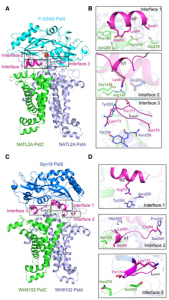To acquire phosphorus, cyanobacteria use the typical bacterial ABC-type phosphate transporter, which is composed of a periplasmic high-affinity phosphate-binding protein PstS and a channel formed by two transmembrane proteins PstC and PstA. A putative pstS gene was identified in the genomes of cyanophages that infect the unicellular marine cyanobacteria Prochlorococcus and Synechococcus. However, it has not been determined whether the cyanophage PstS protein is functional during infection to enhance the phosphate uptake rate of host cells. Here we showed that the cyanophage P-SSM2 PstS protein was abundant in the infected Prochlorococcus NATL2A cells and the host phosphate uptake rate was enhanced after infection. This is consistent with our biochemical and structural analyses showing that the phage PstS protein is indeed a high-affinity phosphate-binding protein. We further modelled the complex structure of phage PstS with host PstCA and revealed three putative interfaces that may facilitate the formation of a chimeric ABC transporter. Our results provide insights into the molecular mechanism by which cyanophages enhance the phosphate uptake rate of cyanobacteria. Phosphate acquisition by infected bacteria can increase the phosphorus contents of released cellular debris and virus particles, which together constitute a significant proportion of the marine dissolved organic phosphorus pool.
Citation: Zhao, F., Lin, X., Cai, K., Jiang, Y., Ni, T., Chen, Y., Feng, J., Dang, S., Zhou, C.-Z. and Zeng, Q. (2022), Biochemical and structural characterization of the cyanophage-encoded phosphate-binding protein: implications for enhanced phosphate uptake of infected cyanobacteria. Environ Microbiol, 24: 3037-3050. https://doi.org/10.1111/1462-2920.16043

